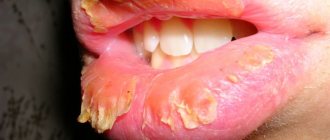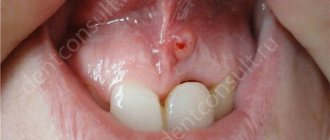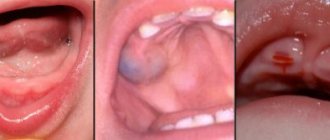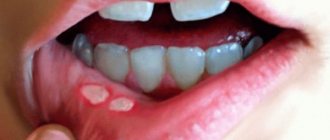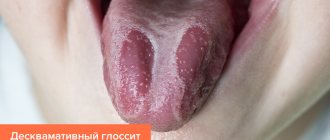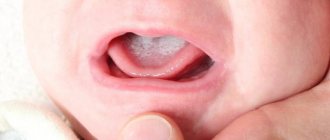General information
The Italian scientist Manganotti discovered a new disease in 1933. The disease was characterized by the formation of erosions on the lower lip. The disease was mainly diagnosed in the male half of the population; in women it was noticeably less common. People over 40 years of age were at risk. Subsequently, the disease became known as Manganotti's cheilitis.
In half of the cases, erosions on the lips led to cancer. That is why Manganotti cheilitis began to be called precancrosis, that is, precancerous. Skin defects in the disease usually affect the lips and the border around them. Cheilitis Manganotti is considered one of the most dangerous diseases of its subgroup. It is considered to be precancerous, but doctors do not know whether the disease will develop into an oncological process. Various factors can provoke the occurrence of cancer in each specific case, for example, work in hazardous work or mechanical damage to the mucous membranes. That is why this dangerous disease requires constant medical supervision.
Causes of the disease
Primary HC is a consequence of congenital pathology of the salivary glands. So, if parents are faced with such a problem, the likelihood that HC will occur in children is almost 100%. It is noteworthy that the initial symptoms of congenital glandular cheilitis appear only after 20 years (the salivary glands increase in size, the amount of secretion they produce increases).
Secondary GC is a complication of the following diseases:
- lupus erythematosus;
- leukoplakia;
- lichen planus.
Constant irritation of the “local” mucosa, which accompanies the course of these ailments, leads to the proliferation of glandular tissue and increased secretion production. The risk of secondary cheilitis increases with chronic diseases of the skin and oral mucosa - periodontitis, periodontal disease, inflammation of the lip mucosa. HC can be caused by the presence of diseased teeth with sharp edges or incorrectly fixed (size-fitted) dentures.
Important! With abnormal expansion of the ducts of the salivary glands, there is a possibility of subsequent infection of them, this, in turn, leads to purulent HC (Folman's cheilitis).
Causes
Doctors note that Manganotti cheilitis is more often diagnosed in older people. It is believed that this may be due to age-related changes in the lip tissue, due to which regeneration occurs much more slowly. The most common causes of the disease:
- injuries;
- hypovitaminosis;
- herpes virus;
- diseases of the gastrointestinal tract;
- wearing dentures;
- chemical irritants;
- abuse of sunbathing.
Manganotti cheilitis most often occurs on the edge of the lower lip. Provoking factors may be dental problems: the absence of some teeth or sharp chips. Improperly made dentures are also dangerous; they can also lead to cheilitis. Smoking can cause many diseases, including Manganotti's disease.
If the lip is constantly injured, this can lead to cheilitis. Patients are advised to break the habit of biting something in their mouth. Excessive sunbathing is not safe and can cause cheilitis.
What it is
Glandular cheilitis is an independent disease that manifests itself in a peculiar lesion of the lower (most often) or upper (much less often) lip, caused by a functional disorder in the structure and functioning of the salivary glands. Such problems in most cases are a consequence of hyperfunction, hyperplasia or heterotopia of the accessory salivary glands located in the area of the oral mucosa.
In the first case, the functional activity of the glands increases. In the second, the glands themselves are subject to enlargement. And the third option involves a malfunction due to a violation of the natural location of the salivary glands. In this case, the glands appear where they should not be, i.e. on the red border of the lips. As a consequence of such deviations, there is an excessively abundant secretion of saliva, which constantly irritates the skin of the lips and provokes the onset of the inflammatory process.
This disease is chronic and most often affects people of pre-retirement and retirement age, regardless of gender, however, men still suffer from this type of cheilitis much more often.
Doctors divide granular cheilitis into two types: primary and secondary. Primary is characterized by congenital abnormalities in the development of the salivary glands, while secondary can manifest itself against the background of serious diseases affecting the lips, for example, leukoplakia, lichen planus, lupus erythematosus. In addition, the formation of simple glandular cheilitis or purulent cheilitis is possible.
Symptoms
Typically, Manganotti cheilitis appears on the border of the lower lip, but it can also occur in the central areas. The disease begins with 1 erosion, less often – with 2-3. Patients complain of mild pain. Symptoms of Manganotti cheilitis:
- Non-bleeding bright red erosions on the lips.
- Skin defects appear and disappear.
- The lips may be swollen, but not inflamed.
- There are no more than 3 erosions, they are smooth and even.
- The person may have difficulty eating and drinking.
If the patient does not consult a doctor, then Manganotti cheilitis will eventually turn into cancer. A person should be concerned about the appearance of erosions on the lips with a perfectly smooth surface. Externally they look as if polished. In shape they most often resemble an oval or circle. Erosions are not prone to bleeding, but if you tear off their top layer, it will still begin. Near the skin defect, the tissue does not change its appearance, only occasionally swelling or redness may be observed.
How the problem manifests itself
HC “announces itself” with classic symptoms - characteristic red dots appear on the border of the lips (seen in the photo above). These are nothing more than the mouths of the salivary glands affected by the disease. If you blot your lips, after a short period of time droplets of secretion will appear on them again. Due to the fact that saliva is produced in excess of normal, the surface of the lips is constantly moisturized. But due to the constant evaporation of liquid, the skin, accustomed to “humidity,” cracks and flakes.
Secondary GC is a complication of skin diseases, pathological processes in the oral cavity, the result of smoking and neglect of the rules of caring for teeth and gums
Diagnostics
An experienced doctor can understand that this is Manganotti cheilitis based only on the appearance of the patient and his interview. Diagnosis is rarely difficult. In doubtful cases, the doctor may recommend a smear from a pathological lesion on the lip. Sometimes scraping from ulcerated tissue may be necessary to clarify the diagnosis. The resulting analysis is examined under a microscope.
When diagnosing, the doctor must be able to distinguish Manganotti cheilitis from similar diseases:
- systemic lupus erythematosus;
- herpes;
- pemphigus;
- lichen planus;
- leukoplakia;
- exudative erythema.
It is very important not to confuse illnesses, since the life and health of the patient depends on this. With Manganotti cheilitis, very rapid degeneration of erosions into cancerous tumors can occur. In some cases, this requires only 4-6 months. Usually, before this, compaction begins to be observed in the erosion; it becomes prone to bleeding even after light abrasions.
Causes and symptoms of appearance on the lips
The causes of development depend on the form of the pathological process.
If there are cases of cheilitis in the family history, then there is a high probability of it occurring in the child. Other causes of the disease include:
- leukoplakia of the lips - keratinization of the mucous epithelium of varying severity;
- lichen planus – chronic dermatosis with the formation of papules;
- Lupus erythematosus is an autoimmune disease;
- periodontal disease, periodontitis – gum pathologies;
- decayed teeth with sharpened edges;
- prostheses with a violation of linear dimensions or poorly fitted.
Changes in the structure of the salivary glands increase the risk of infection by pathogenic flora. In this case, a purulent form of glandular cheilitis is diagnosed.
It has characteristic symptoms. Patients present the following complaints:
- the presence of a red border or small red dots on the mucous membrane of the lips;
- salivation after blotting lips;
- the skin is constantly moisturized;
- there are cracks and peeling on the lips;
- itching;
- over time, the skin becomes keratinized;
- areas of leukoplakia appear.
The purulent form of the disease is characterized by pronounced symptoms. During the examination, the doctor will see:
- swelling of the lips;
- pain syndrome is present;
- hyperemia of the integument;
- the appearance of purulent crusts;
- salivary glands are dense, hypertrophied;
- discharge of pus from the gland;
- in severe cases – the addition of lymphadenitis, general intoxication;
- the appearance of abscesses.
During the examination, herpes, syphilis, furunculosis, and malignant neoplasms of the oral mucosa should be excluded.
Drug treatment
It is very important to remove all irritating factors. If your teeth hurt, they need to be treated. If your gums are bleeding, you need to determine the cause and eliminate it. Doctors recommend applying applications to erosions. The patient is prescribed an oil solution of vitamin A for food, since its deficiency can contribute to the development of Manganotti cheilitis. But more often doctors choose surgical treatment. If this is undesirable for any reason, then medications are used.
To treat Manganotti cheilitis, novocaine blockades and epithelializing ointments containing vitamin A are used. Drugs that improve blood supply to small vessels have a good effect. Many doctors recommend additionally prescribing vitamin P to the patient. The patient can also be prescribed ointments that have a healing effect, for example, Solcoseryl.
Surgery
In itself, Manganotti cheilitis, before it degenerates into a cancerous tumor, does not pose a serious danger to human health and life. But no doctor can say for sure at what point cancer will develop. In some patients, cheilitis degenerates into cancer after 5 months, in others - after 6-7 years. Usually, ulcers are first treated with medications, and then the patient is sent for surgery. Only surgery offers a real chance for a complete recovery.
When treating Manganotti cheilitis, doctors excise the affected tissue and then conduct a histological examination of it. If degeneration has already begun, then a surgical solution to the problem is also recommended. Before the intervention, the patient will need to consult an oncologist. After surgery, if necessary, the doctor prescribes a course of chemotherapy. If Manganotti's chelitis has degenerated into oncology, then the patient will face a longer rehabilitation period.
Prevention
People who have dentures should be careful. This is especially true for older men, who are most prone to cheilitis. Dentures should be comfortable; rubbing and discomfort should not be tolerated. Lips should be protected even from minor injuries, as they can provoke the development of the disease. At the first symptoms of the disease, you need to go to the doctor.
During training, doctors carefully study photos of Manganotti cheilitis, so sometimes even a simple examination is enough to make a diagnosis. Health professionals advise avoiding prolonged sunbathing. All dental diseases must be treated in a timely manner; they can also contribute to the appearance of cheilitis.
Patients prone to illness need to spend more time boosting their immunity. It is advisable not to come into contact with harmful chemicals. Women should use only high-quality cosmetics that have passed dermatological tests on their lips.
Traditional methods of treatment
Precancrosis Manganotti cheilitis is a dangerous disease that can lead to the development of cancer. Sometimes it takes only 5-6 months for it to degenerate into a cancerous tumor. It is not recommended to treat cheilitis with folk remedies without consulting a doctor. The patient may miss time, and then it will be more difficult to help him. Traditional methods of treatment can only be a complement to traditional therapy.
Herbalists recommend making lotions with aloe juice. It must be mixed with vegetable oil in a ratio of 1 to 3. The drug must be applied 3 times a day. Tampons with St. John's wort also have a good effect. The patient pours 3 tablespoons of the herb into a quarter liter of water and puts it on the fire for 20 minutes. After the broth is cooled, tampons are soaked in it and applied to the ulcers 5 times a day for 10 minutes.
Treatment
If symptoms of this disease are detected, the patient should seek help from a dentist, dermatologist and infectious disease specialist as soon as possible. ointments that relieve inflammation are still used : hydrocortisone, prednisolone or naphthalan.
In case of secondary cheilitis, it is more logical to resort to this type of treatment for granular cheilitis, such as diathermocoagulation . The essence of this procedure is to cauterize pathological and hypertrophied glands with electric current using a thin electrode. Another treatment option is surgical excision of such glands. Lack of timely treatment can lead to the formation of lip cancer.
